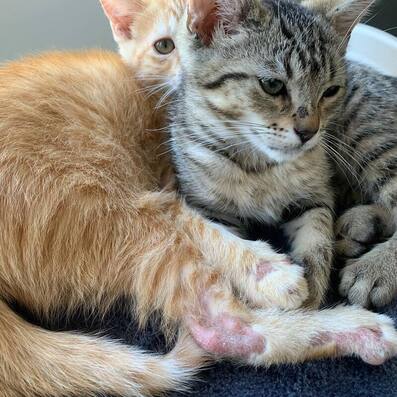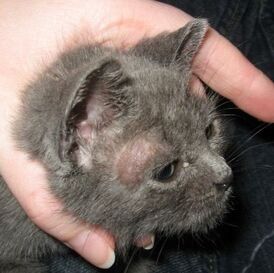Ringworm

Symptoms and Treatment
Problem: Ringworm is the most common fungal infection in cats and is easily treatable. The fungus has a two week incubation period between exposure and the presence of symptoms but the fungus is transmissible before symptoms even occur. Severe cases of ringworm are more common in kittens and adult cats with poor immune systems.
Ringworm does not involve any worms infecting the cat, rather it is named ringworm because of the circular rashes that can appear on the skin.
Symptoms:
Diagnosis: Ringworm can be diagnosed by examining the cat’s skin and coat with a Wood’s lamp (blacklight) but this method may not always be effective. Examination of a skin culture in a laboratory is the preferred method of diagnosis.
Treatment: Treatments should be used for at least six weeks to ensure that the fungus is truly gone. It is best to use multiple treatment options to ensure the fungus is cured. Some treatments like oral medication and topical treatments will not fully treat the infection and should not be used alone. Treatment usually involves a topical anti-fungal medication, a systemic medication, and/or a full body rinse or dip. Allowing your cat to “self-resolve” is not recommended as this process can take up to a year and the cat can lose a large amount of fur.
Tips for shelters:
Problem: Ringworm is the most common fungal infection in cats and is easily treatable. The fungus has a two week incubation period between exposure and the presence of symptoms but the fungus is transmissible before symptoms even occur. Severe cases of ringworm are more common in kittens and adult cats with poor immune systems.
Ringworm does not involve any worms infecting the cat, rather it is named ringworm because of the circular rashes that can appear on the skin.
Symptoms:
- Flaky, circular bald spots surrounded by red rings (usually around the head, ears, forelimbs, whiskers, toes and tail)
- Broken and stubbly hair
- Alterations in hair or skin color
- Skin inflammation
- Excessive grooming
- Dandruff
- Infection of claws
- Dermatitis
Diagnosis: Ringworm can be diagnosed by examining the cat’s skin and coat with a Wood’s lamp (blacklight) but this method may not always be effective. Examination of a skin culture in a laboratory is the preferred method of diagnosis.
Treatment: Treatments should be used for at least six weeks to ensure that the fungus is truly gone. It is best to use multiple treatment options to ensure the fungus is cured. Some treatments like oral medication and topical treatments will not fully treat the infection and should not be used alone. Treatment usually involves a topical anti-fungal medication, a systemic medication, and/or a full body rinse or dip. Allowing your cat to “self-resolve” is not recommended as this process can take up to a year and the cat can lose a large amount of fur.
- Itraconazole. This is the preferred medication for treatment of ringworm. It’s only known potential adverse reaction is anorexia.
- Terbinatine. This is an oral pill given twice a day for 2 weeks. The pill can stay effective for 5 weeks after treatment has ended. Oral medication only kills the fungus internally.
- Lime Sulphur dip. This is an effective, safe and inexpensive treatment that can be done at home. The dips should be given once a week until the cat’s skin culture comes back negative for ringworm and the dip should be used for all animals in the home. It is important to allow the dip to airdry on the cat’s fur.
- Topical medication. Topical medication is less effective in cats than humans because the medication has difficulty seeping through the fur and there is a possibility of hidden lesions. The hairs around the lesions should be clipped away to make the topical medication more effective. Topical medication only treats the hair follicles and does not cure the fungus.
- Medicated shampoo baths.
- Cleaning. Microscopic fungal spores can be shed from the infected cat into the environment and can stay in the environment for up to a year. Therefore, ringworm could come back after treatment if the spores are still in the atmosphere. The cat’s bedding and toys should be washed and areas where cat hair accumulates should be regularly vacuumed.
- Decrease stress. Stress can lower the immune system and lead to further spread of the fungus.
Tips for shelters:
- Put infected cats in isolation to prevent further spread of ringworm. Provide this cat with enrichment so stress levels stay low.
- Note which cats came into the shelter together. The ringworm infection likely could have affected multiple cage mates.
- Use a lime Sulphur dip once you suspect a fungal infection. Use the lime Sulphur dip 2-4 times before allowing the cat to go to foster care.
- Clean the healthiest cats first.
- Wear separate clothing when handling cats with ringworm to prevent spread to non-infected cats.
- Make sure foster homes with infected cats are following the same cleaning procedures.

Ringworm Myths Debunked
Ringworm cats are one of the highest risk groups for euthanasia in the US. This is largely because of fear, myth, and stigma. There are also a lot of antiquated ideas of how ringworm is spread. The biggest problem with ringworm is only the length of time it takes to treat. Treatment takes anywhere from a few weeks to a few months.
Ringworm is largely present in kittens because of weak immune systems. Shelter kittens with ringworm face extra hurdles to making it out. While sequestered, they are not getting the socialization they need for healthy mental development. The adoption window is also compromised, as they are in isolation while they are cute and tiny. For all cats, the longer they stay in a shelter, the higher chance there is for them to become more seriously ill. Their mental health is also at risk. Furthermore shelters run out of space when keeping ringworm positive cats long term. Resources are also stretched, as it is expensive to keep and treat the cats.
So how do we reduce the length of stay for cats and kittens with ringworm? This can be combatted by allowing cats and kittens to be adopted with ringworm. The first step is letting people interact with cats and kittens with ringworm in the shelters. There is a low risk for environmental transmission; the highest risk is cat to cat contact. The second step is to educate the public and reduce the stigma surrounding ringworm. Incentivizing adoptions is also important; reduce or eliminate adoption fees for cats with ringworm. Once a ringworm positive cat has been adopted, they are sent home with the rest of their treatment. The adopter is also trained on how to administer treatment, etc. Handouts and FAQs are also helpful. If a shelter is concerned about a member of the public will contract ringworm from interacting with the cats, they can ask the public to sign a waiver. However, this is not necessary.
Some common concerns are that vets won’t let animals in treatment go home until they’re 100%, but in this case no shelters could be no-kill shelters. Another is that your local vets protest. If this is the case, visit another vet. Finally, concerns that the community isn’t ready to adopt these cats. However, the community isn’t aware that these cats are dying, so educating them on ringworm and the situation these cats and kittens are in will make a big difference.
Ringworm cats are one of the highest risk groups for euthanasia in the US. This is largely because of fear, myth, and stigma. There are also a lot of antiquated ideas of how ringworm is spread. The biggest problem with ringworm is only the length of time it takes to treat. Treatment takes anywhere from a few weeks to a few months.
Ringworm is largely present in kittens because of weak immune systems. Shelter kittens with ringworm face extra hurdles to making it out. While sequestered, they are not getting the socialization they need for healthy mental development. The adoption window is also compromised, as they are in isolation while they are cute and tiny. For all cats, the longer they stay in a shelter, the higher chance there is for them to become more seriously ill. Their mental health is also at risk. Furthermore shelters run out of space when keeping ringworm positive cats long term. Resources are also stretched, as it is expensive to keep and treat the cats.
So how do we reduce the length of stay for cats and kittens with ringworm? This can be combatted by allowing cats and kittens to be adopted with ringworm. The first step is letting people interact with cats and kittens with ringworm in the shelters. There is a low risk for environmental transmission; the highest risk is cat to cat contact. The second step is to educate the public and reduce the stigma surrounding ringworm. Incentivizing adoptions is also important; reduce or eliminate adoption fees for cats with ringworm. Once a ringworm positive cat has been adopted, they are sent home with the rest of their treatment. The adopter is also trained on how to administer treatment, etc. Handouts and FAQs are also helpful. If a shelter is concerned about a member of the public will contract ringworm from interacting with the cats, they can ask the public to sign a waiver. However, this is not necessary.
Some common concerns are that vets won’t let animals in treatment go home until they’re 100%, but in this case no shelters could be no-kill shelters. Another is that your local vets protest. If this is the case, visit another vet. Finally, concerns that the community isn’t ready to adopt these cats. However, the community isn’t aware that these cats are dying, so educating them on ringworm and the situation these cats and kittens are in will make a big difference.
Referneces
Frymus, T. et al. (2013). Dermatophytosis in Cats. Journal of Feline Medicine and Surgery, 15, 598-604.
Moriello, K. (July 12, 2012). How Animal Shelters Are Beating Ringworm (And Yours Can, Too!). Retrieved from http://www.maddiesfund.org/assets/documents/Resource%20Library/Ringworm%20Audience%20QA.pdf
Ringworm: A Serious but Readily Treatable Affliction. (n.d). Retrieved from http://www.vet.cornell.edu/fhc/Health_Information/ringworm.cfm
Ringworm in Cats. (n.d). Retrieved from https://pets.webmd.com/cats/ringworm-in-cats#2
Ward, E. (December 2, 2008). Ringworm in Cats. Retrieved from https://vcahospitals.com/know-your-pet/ringworm-in-cats
Frymus, T. et al. (2013). Dermatophytosis in Cats. Journal of Feline Medicine and Surgery, 15, 598-604.
Moriello, K. (July 12, 2012). How Animal Shelters Are Beating Ringworm (And Yours Can, Too!). Retrieved from http://www.maddiesfund.org/assets/documents/Resource%20Library/Ringworm%20Audience%20QA.pdf
Ringworm: A Serious but Readily Treatable Affliction. (n.d). Retrieved from http://www.vet.cornell.edu/fhc/Health_Information/ringworm.cfm
Ringworm in Cats. (n.d). Retrieved from https://pets.webmd.com/cats/ringworm-in-cats#2
Ward, E. (December 2, 2008). Ringworm in Cats. Retrieved from https://vcahospitals.com/know-your-pet/ringworm-in-cats